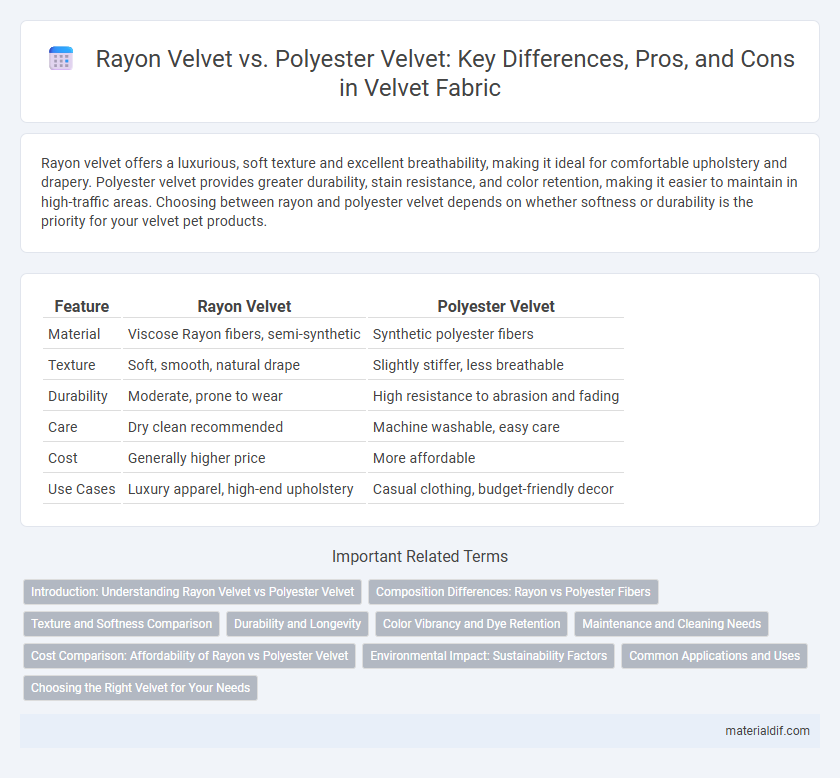Rayon velvet offers a luxurious, soft texture and excellent breathability, making it ideal for comfortable upholstery and drapery. Polyester velvet provides greater durability, stain resistance, and color retention, making it easier to maintain in high-traffic areas. Choosing between rayon and polyester velvet depends on whether softness or durability is the priority for your velvet pet products.
Table of Comparison
| Feature | Rayon Velvet | Polyester Velvet |
|---|---|---|
| Material | Viscose Rayon fibers, semi-synthetic | Synthetic polyester fibers |
| Texture | Soft, smooth, natural drape | Slightly stiffer, less breathable |
| Durability | Moderate, prone to wear | High resistance to abrasion and fading |
| Care | Dry clean recommended | Machine washable, easy care |
| Cost | Generally higher price | More affordable |
| Use Cases | Luxury apparel, high-end upholstery | Casual clothing, budget-friendly decor |
Introduction: Understanding Rayon Velvet vs Polyester Velvet
Rayon velvet is crafted from natural cellulose fibers derived from wood pulp, offering a soft texture and breathable quality with a luxurious sheen. Polyester velvet, made from synthetic polymers, provides superior durability, wrinkle resistance, and vibrant color retention. Understanding these fabric differences helps in selecting the ideal velvet type for specific applications such as upholstery, fashion, or home decor.
Composition Differences: Rayon vs Polyester Fibers
Rayon velvet is crafted from cellulose fibers derived from natural sources like wood pulp, offering a soft, breathable texture with a lustrous finish that mimics silk. Polyester velvet is made from synthetic polymer fibers, providing greater durability, wrinkle resistance, and color retention but with less breathability compared to rayon. The fundamental composition difference lies in rayon's natural cellulose base versus polyester's synthetic origin, impacting the fabric's feel, moisture-wicking properties, and care requirements.
Texture and Softness Comparison
Rayon velvet features a luxurious, smooth texture with a natural sheen, offering a supple softness that feels gentle against the skin. Polyester velvet, while also soft, tends to have a slightly stiffer texture with less breathability due to its synthetic fibers. The natural origin of rayon fibers provides a more breathable, plush feel compared to the durable but less airy polyester velvet.
Durability and Longevity
Rayon velvet offers a luxurious texture but tends to be less durable and more prone to wear over time compared to polyester velvet. Polyester velvet is known for its superior resistance to abrasion, maintaining its plush appearance and color retention even after extensive use. For applications requiring long-lasting fabric with minimal maintenance, polyester velvet is the preferred choice due to its enhanced longevity and resilience.
Color Vibrancy and Dye Retention
Rayon velvet exhibits superior color vibrancy due to its natural fiber composition, allowing dyes to penetrate deeply and produce rich, luminous hues. Polyester velvet, while more durable, tends to have a synthetic fiber base that can result in slightly less intense colors but offers excellent dye retention over time. The choice between rayon and polyester velvet hinges on prioritizing vivid color brilliance versus long-lasting dye stability for various textile applications.
Maintenance and Cleaning Needs
Rayon velvet requires gentle cleaning methods such as dry cleaning to maintain its softness and prevent fabric damage, while polyester velvet is more durable and can often be machine washed or spot cleaned without losing its texture. Rayon velvet is prone to shrinking and must avoid excessive moisture, making it less suitable for high-maintenance environments. Polyester velvet resists wrinkles and is more stain-resistant, making it ideal for everyday use with minimal upkeep.
Cost Comparison: Affordability of Rayon vs Polyester Velvet
Rayon velvet generally offers a moderate price point, making it an affordable luxury fabric option compared to silk velvet but typically more expensive than polyester velvet. Polyester velvet is usually the most budget-friendly choice, providing durability and ease of care at a lower cost, ideal for cost-conscious consumers. When comparing rayons and polyesters, the price difference plays a crucial role depending on intended use, with polyester excelling in affordability and rayon favored for a more natural feel.
Environmental Impact: Sustainability Factors
Rayon velvet, derived from regenerated cellulose fibers, is considered more eco-friendly due to its biodegradable nature and lower reliance on fossil fuels compared to polyester velvet, which is produced from non-biodegradable synthetic fibers derived from petroleum. The production of polyester velvet involves energy-intensive processes that contribute significantly to carbon emissions and microplastic pollution. Rayon velvet, while more sustainable, still faces environmental concerns related to chemical usage in its manufacturing process, highlighting the importance of choosing viscose from responsibly managed sources to minimize ecological impact.
Common Applications and Uses
Rayon velvet is commonly used in luxury apparel, upholstery, and drapery due to its soft texture and breathable properties, making it ideal for garments and home decor requiring comfort and elegance. Polyester velvet is favored in commercial and high-traffic applications like theater curtains, event decorations, and durable upholstery because of its resilience, stain resistance, and ease of maintenance. Both fabrics serve distinct purposes, with rayon velvet emphasizing softness and natural fiber appeal, while polyester velvet offers durability and cost-effectiveness for practical uses.
Choosing the Right Velvet for Your Needs
Rayon velvet offers a luxurious feel and breathability, making it ideal for upholstery and clothing where comfort is key, while polyester velvet provides greater durability, stain resistance, and ease of maintenance, suited for high-traffic areas or budget-friendly projects. Consider the specific needs of your space or garment, such as exposure to wear, cleaning frequency, and desired texture, when choosing between rayon and polyester velvet. Selecting the right velvet fabric balances aesthetic appeal with practical functionality to ensure long-lasting satisfaction.
Rayon Velvet vs Polyester Velvet Infographic

 materialdif.com
materialdif.com